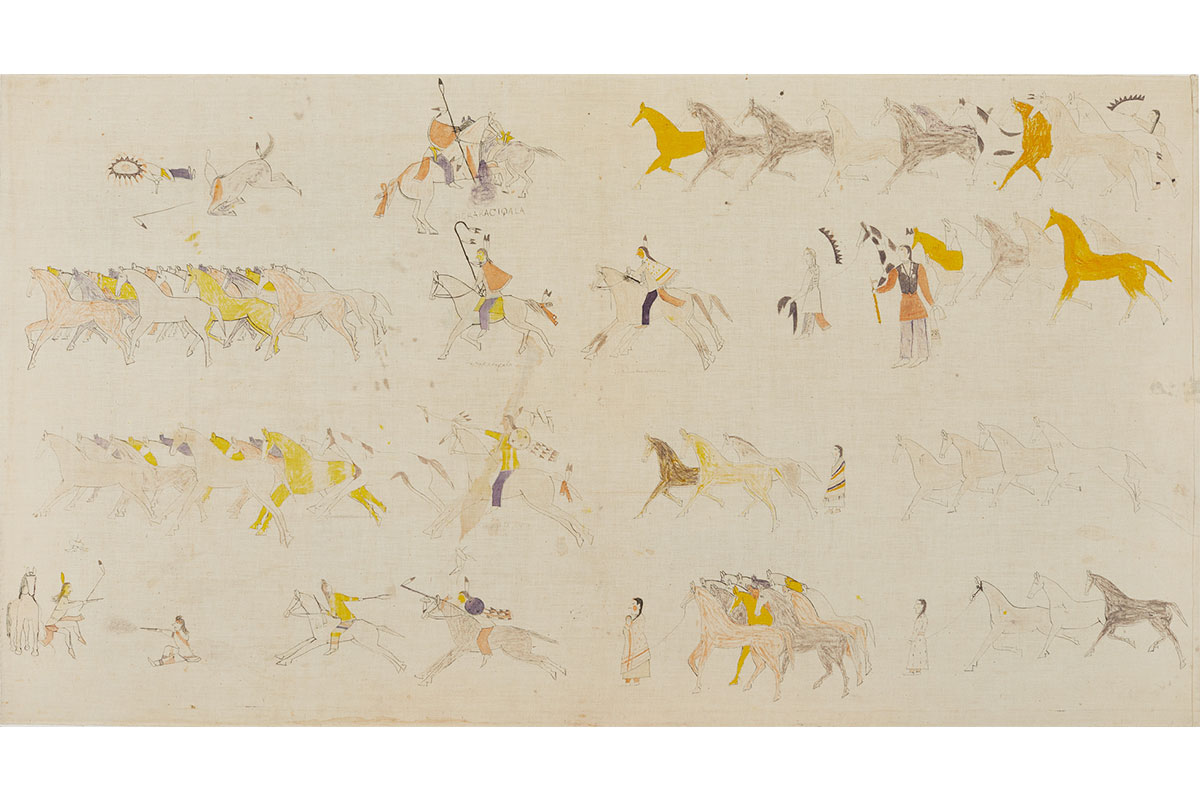Pictorial Muslin
Standing Rock Reservation, North and South Dakota
ca. 1890
ink and coloured ink on muslin
height: 35 ½"
width: 64 ¾"
Inventory # P4407-2
Sold
PROVENANCE
Private collection, New Mexico
RELATED EXAMPLE
For a pictographic muslin by the same artist depicting the exploits of Cehupa (Jaw) reportedly collected at Fort Yates, South Dakota between 1885-1900 by Dr. Edwin Smith, a contract doctor with the U.S. Indian Service see:
Hood Museum of Art, Dartmouth, Cat. No. 2009.10 – See: George P. Horse Capture, Sr., Joe D. Horse Capture, Joseph M. Sanchez, et al., Native American Art at Dartmouth: Hightlights from the Hood Museum of Art, Hanover: Trustees of Dartmouth College, 2011, pgs. 20, 34, 109 and 165, no. 113 for a pictographic muslin by the same artist depicting the exploits of Cehupa (Jaw)
Pictographic painted panels on muslin or canvas evolved from an earlier tradition of painted hide tipi liners, an ingenious architectural device attached to the lower interior of a tipi to guide smoke along the inside wall and through the smoke hole at the top. The appearance of painted muslins in the late 19th century coincides with the forced relocation of Native American families and communities into log cabins on reservations. Artists cleverly adopted the earlier pictographic tradition of the tipi liner, utilising newly available materials such as muslin and coloured ink to create large-scale paintings to be fixed around the interior of their cabins. In later years, cloth cabin liners were frequently commissioned or sold to U.S. military personal, anthropologists and tourists.
In contrast to tipi liners, pictorial muslins frequently depict the exploits of one or a number of protagonists, referencing events recognised as important by the community. As such, pictographic muslins serve as mnemonic devices of personal and collective histories similar to winter counts and Ledger Art. The extraordinary muslin illustrated here is unusual in the sheer number of scenes depicted, each vignette accompanied by handwritten inscriptions in Lakota. According to Christina Burke, curator of Native American art at the Philbrook Museum of Art in Tulsa, Oklahoma, some of the protagonists can be identified as Mato Luta (Red Bear), Mehaka Ciqala (Little Elk), Mato Nape Ska (White Paw Bear) and Kangi Ohitika (Brave Crow). These men appear on the 1885 ration rolls for the Standing Rock Reservation, strengthening the attribution of this muslin to a Hunkpapa Lakota artist.
The quality of each pictorial element is superb, the figures all confidently rendered. Many scenes capture horse raids and battles with Apsáalooke warriors. The richness of detail is notable, including the careful presentation of protective images such as spirit animals or the celestial constellations on various shields, among the most prized possessions of a Plains warrior in the 19th century. Similarly noteworthy is the variety of body poses, ranging from warriors charging at enemies to those ducking away or spread on the ground in defeat. This muslin was clearly painted by a high-ranking artist, capturing the exploits of many of his peers with exceptional virtuosity.










